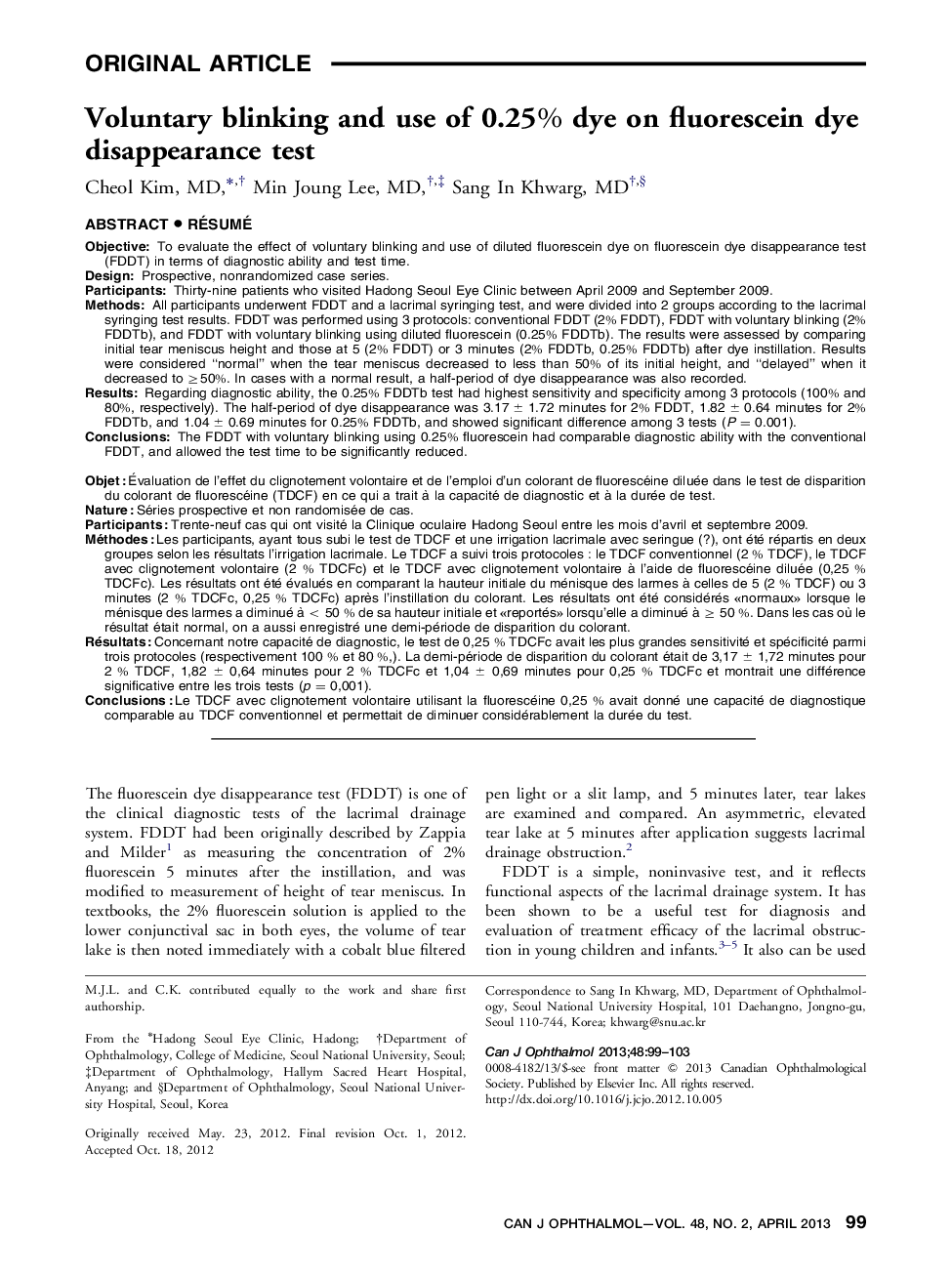| کد مقاله | کد نشریه | سال انتشار | مقاله انگلیسی | نسخه تمام متن |
|---|---|---|---|---|
| 4009218 | 1602410 | 2013 | 5 صفحه PDF | دانلود رایگان |

ObjectiveTo evaluate the effect of voluntary blinking and use of diluted fluorescein dye on fluorescein dye disappearance test (FDDT) in terms of diagnostic ability and test time.DesignProspective, nonrandomized case series.ParticipantsThirty-nine patients who visited Hadong Seoul Eye Clinic between April 2009 and September 2009.MethodsAll participants underwent FDDT and a lacrimal syringing test, and were divided into 2 groups according to the lacrimal syringing test results. FDDT was performed using 3 protocols: conventional FDDT (2% FDDT), FDDT with voluntary blinking (2% FDDTb), and FDDT with voluntary blinking using diluted fluorescein (0.25% FDDTb). The results were assessed by comparing initial tear meniscus height and those at 5 (2% FDDT) or 3 minutes (2% FDDTb, 0.25% FDDTb) after dye instillation. Results were considered “normal” when the tear meniscus decreased to less than 50% of its initial height, and “delayed” when it decreased to≥50%. In cases with a normal result, a half-period of dye disappearance was also recorded.ResultsRegarding diagnostic ability, the 0.25% FDDTb test had highest sensitivity and specificity among 3 protocols (100% and 80%, respectively). The half-period of dye disappearance was 3.17±1.72 minutes for 2% FDDT, 1.82±0.64 minutes for 2% FDDTb, and 1.04±0.69 minutes for 0.25% FDDTb, and showed significant difference among 3 tests (P = 0.001).ConclusionsThe FDDT with voluntary blinking using 0.25% fluorescein had comparable diagnostic ability with the conventional FDDT, and allowed the test time to be significantly reduced.
RésuméObjetÉvaluation de l'effet du clignotement volontaire et de l'emploi d'un colorant de fluorescéine diluée dans le test de disparition du colorant de fluorescéine (TDCF) en ce qui a trait à la capacité de diagnostic et à la durée de test.NatureSéries prospective et non randomisée de cas.ParticipantsTrente-neuf cas qui ont visité la Clinique oculaire Hadong Seoul entre les mois d'avril et septembre 2009.MéthodesLes participants, ayant tous subi le test de TDCF et une irrigation lacrimale avec seringue (?), ont été répartis en deux groupes selon les résultats l'irrigation lacrimale. Le TDCF a suivi trois protocoles : le TDCF conventionnel (2 % TDCF), le TDCF avec clignotement volontaire (2 % TDCFc) et le TDCF avec clignotement volontaire à l'aide de fluorescéine diluée (0,25 % TDCFc). Les résultats ont été évalués en comparant la hauteur initiale du ménisque des larmes à celles de 5 (2 % TDCF) ou 3 minutes (2 % TDCFc, 0,25 % TDCFc) après l'instillation du colorant. Les résultats ont été considérés «normaux» lorsque le ménisque des larmes a diminué à < 50 % de sa hauteur initiale et «reportés» lorsqu'elle a diminué à ≥ 50 %. Dans les cas où le résultat était normal, on a aussi enregistré une demi-période de disparition du colorant.RésultatsConcernant notre capacité de diagnostic, le test de 0,25 % TDCFc avait les plus grandes sensitivité et spécificité parmi trois protocoles (respectivement 100 % et 80 %,). La demi-période de disparition du colorant était de 3,17 ± 1,72 minutes pour 2 % TDCF, 1,82 ± 0,64 minutes pour 2 % TDCFc et 1,04 ± 0,69 minutes pour 0,25 % TDCFc et montrait une différence significative entre les trois tests (p = 0,001).ConclusionsLe TDCF avec clignotement volontaire utilisant la fluorescéine 0,25 % avait donné une capacité de diagnostique comparable au TDCF conventionnel et permettait de diminuer considérablement la durée du test.
Journal: Canadian Journal of Ophthalmology / Journal Canadien d'Ophtalmologie - Volume 48, Issue 2, April 2013, Pages 99–103